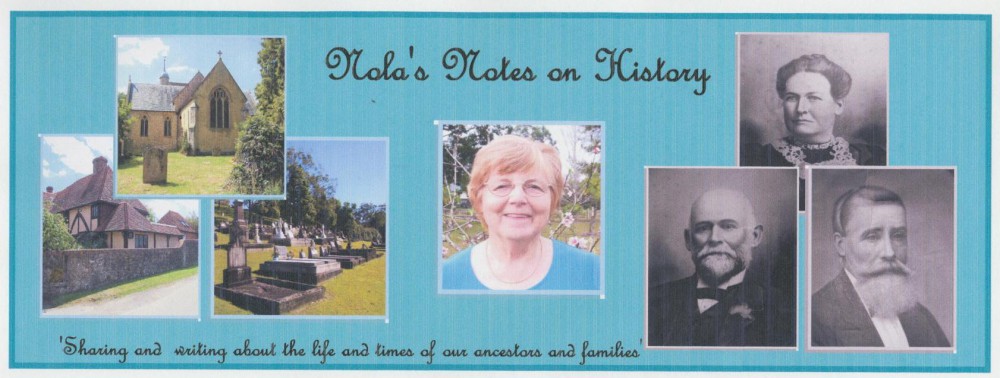In former blogs, I told the story of my maternal grandparents, Arthur Baxter and Harriet May Bell’s romance, long engagement, and finally their marriage.
Harriet May was known by her friends and family by her second name, May. May’s father, John Bell had instructed Arthur that his new bride had been raised as a lady, and she should not be expected to live in a bush camp as Arthur and his mates had done for the four previous years.
When the couple reached Murwillumbah, Arthur decided to ride out to Chillingham to visit friends from Camden, the Doust family. Several members of the Doust family had moved to the Richmond River just after the turn of the 20th century. Young Bert and Edwin Doust, who were about Arthur’s age, had taken up land at Chillingham, on the Tweed. They had cleared a few acres and built a slab hut. Two of their sisters, Emily and Olive, also lived with them. Arthur thought May might be able to stay with the Doust girls until he could find a suitable house to rent. Consequently, Arthur left May at the Murwillumbah hotel while he went on his mission.
However, in the hotel dining room that night, May met Mr. Harry Grant, who had just brought his wife, who was very ill, to Murwillumbah, to have their sixth child. He had called at the hotel, because of a terrible storm, but he informed May that he had to leave early in the morning for his farm at Mt Burrell, about twenty miles away in the bush. He had left the five young children at home with a friend, who not only was keeping an eye on the children, but had nearly 100 cows to milk by hand. He was worried about their safety, as although neighbours had promised to keep an eye on them too, a couple of young aboriginal men in the district had proved troublesome.
May was very concerned, particularly for the young children, the youngest not yet two years of age, should be left so. She insisted that she should go with him to care for the children until their mother’s return.

The falls on the South Arm near Grants Farm- Original owned by Nola Mackey
The Grant selection was on the Rous or South Arm of the Tweed River. The selectors in the area were clearing the scrub to plant pastures for dairy farming.
The Grant home at that stage was little more than a bush slab hut with added rooms as the family grew. (It was further around the hill and closer to the creek than the Grant homes today. Years ago you could see the house stumps under a big old Moreton Bay fig. The old road wound around the hills rather than following the creek as it does today).
May had to learn to cook in a camp oven over an open fire, which she had never done before. She never had the cooking duty at home. Her sister Ollie did that.
She had to make her own yeast for the bread for the family and ‘workers’. These were young men clearing the scrub on Grant’s Selection.
Years later she would entertain her granddaughters with stories about her many cooking disasters during that time.
Water was heated for bathing the children and washing the clothes, in buckets made from 4-gallon kerosene tins precariously slung over the coals. The water was hauled from the creek in those same buckets. Wash days were an all-day affair with that sized family.
It was at the Grant home, Arthur found his bride a week later. Although Arthur had made the arrangements for May to live at the Doust’s at Chillingham, as planned, she refused to leave the Grant children in such circumstances. So the couple stayed with the Grants for several weeks, and May undertook the duties of caring for the children, cooking, and other household chores until Mrs. Grant’s return home.
Arthur, who had been brought up on a dairy farm was able to milk and could assist Harry Grant with other farming duties.

Rous or South Arm of the Tweed River near Grant’s Farm-
Original owned by Nola Mackey
There were times when the men were late returning to milk the cows in the evening, and May was required to help milk, although she had no experience. Much to the amusement of the menfolk, not only at Grant’s but other farms in the district, she arrived at the milking bails in full dress, including a clean and freshly starched kitchen apron, stockings, court shoes, and make-up.
Years later some of these men admitted to May that they had bets amongst themselves that she wouldn’t last a month farming and would return to Picton.
In fact, she adjusted over time and outlasted them all. She went on to farm with Arthur in that area for nearly fifty years despite floods, droughts, fire, and wartime restrictions.
They were still living on the farm when Arthur died in 1959.



 John Bell’s Blacksmith Shop at Thirroul c 1914 [original held by Nola Mackey]
John Bell’s Blacksmith Shop at Thirroul c 1914 [original held by Nola Mackey]















